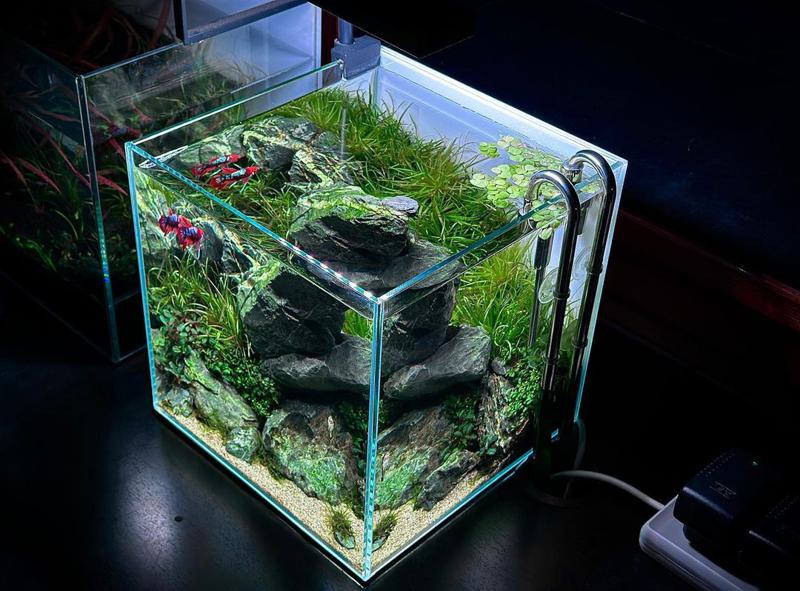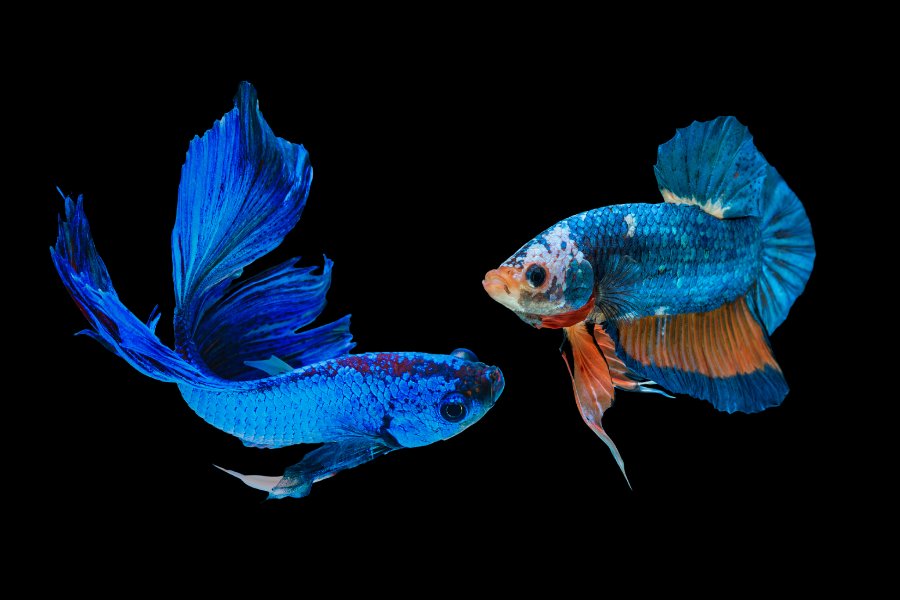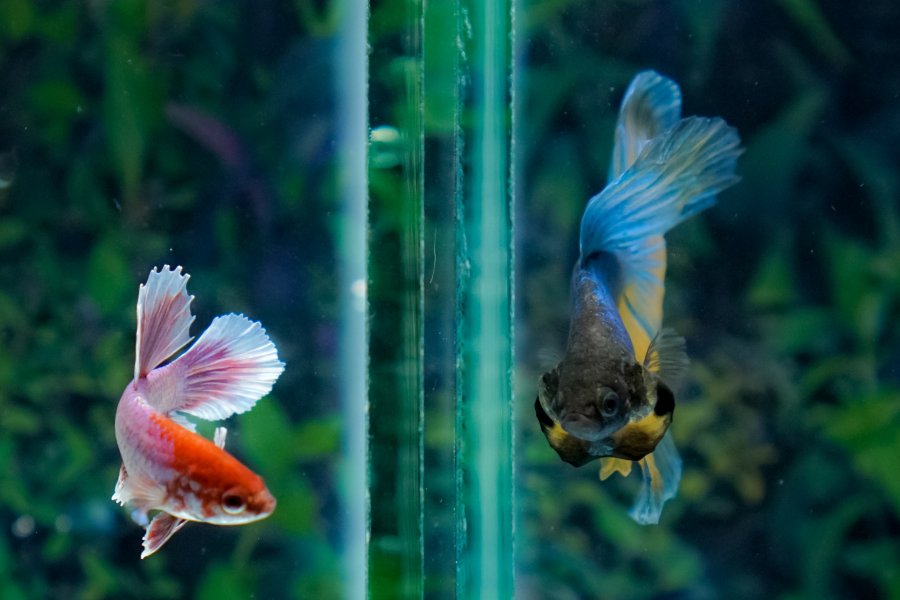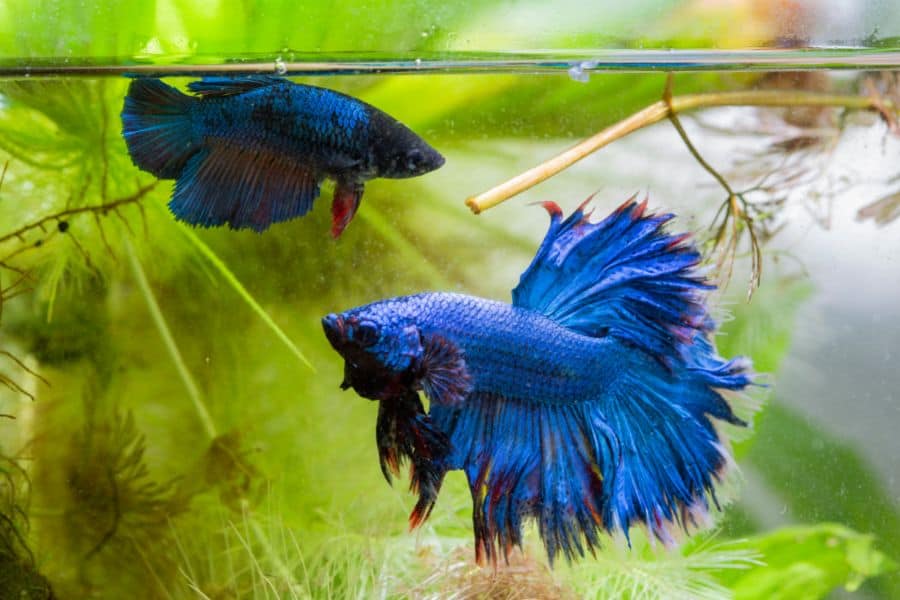For both experienced and novice aquarium owners alike, bettas are among the most popular choices of fish to keep due to their beautiful appearance and their low maintenance requirements.
However, they are known as “Siamese fighting fish” for good reason – and this is due to their aggressive nature when faced with others of their own kind.
But what about males and females? Surely they must get along, if only for mating, right?
Well, not really, as it turns out – and to help you understand why, in this post, we answer the question, can you put a male and female betta together?
The Short Answer
Let’s start with the short answer: no, you can’t.
If you put two males in the same tank, there is a high likelihood that they will fight and injure each other – and sometimes, they may even kill each other.
However, even if you put a male and female in the same aquarium, males display such aggressive territorial behavior towards members of their own species that they will even attack the female.
There are some exceptions to this – for example, when breeding them, which we’ll come to later – but if you want a simple answer to the question, that’s it. As a rule, you shouldn’t keep male and female betta fish together.
Now let’s have a look at the question in more detail.
Betta Behavior
To understand why male and female betta fish don’t get on, we need to talk more about their behavior, both in the wild and in captivity.
Bettas in The Wild
What we normally think of as the domestic betta fish is known scientifically as Betta splendens, and it is found in the wild in Thailand as well as in some neighboring countries like Laos and Cambodia.
It is adapted to living in low-oxygen environments, which allows it to thrive in habitats such as rice paddies and slow-moving streams, and it is thought to have been domesticated as much as 1,000 years ago.
In the wild, male bettas defend their territory aggressively, and it was this aggressivity that first caught people’s attention – centuries ago, people in what is now Thailand used to catch the fish and pit them against one another in fights, betting on the winner.
Breeding Behavior
Of course, betta males and females need to come together to breed, at which time males will tolerate females.
However, once courtship is over and the eggs have been fertilized, the male chases her away – this is because if she stays, there’s a risk she will try to eat the newly fertilized eggs!
Betta Behavior in Captivity
In the wild, bettas rarely fight to the death – rather, after a brief skirmish, the weaker fish will retreat, leaving the winner in peace.
However, this only works because the defeated fish has somewhere to retreat to – something not possible in a small aquarium.
For this reason, if bettas are kept together in aquariums, fights can quickly get out of hand, leading to serious injuries or even death in one or both fish.
This is especially true of two males being kept together, but if a male and female are kept in the same tank and have nowhere to hide, they will also fight, potentially to the death.
What About for Breeding?
So if bettas are so aggressive towards one another, how do they reproduce? How can a female tell when a male will tolerate her presence in his territory?
The answer is that when a male sees a female and wishes to breed, he begins constructing something known as a “bubble nest”.
A bubble nest is more or less what it sounds like and consists of bubbles floating on the water’s surface and usually attached to something like a rock or plant, which, after successful breeding, will be where the fertilized eggs are deposited.
When a male begins constructing his bubble nest, the female knows she can approach, which she will do if she is also receptive. Both fish may also flare their fins or display vertical stripes, which are other signs of their willingness to mate.
Then, after a courtship ritual that can last up to three hours – and that can also include some aggressive behavior on the male’s part such as chasing or nipping the female – the female releases her eggs, and the male fertilizes them.
After this, the male deposits the eggs in the bubble nest and the female departs – or, in captivity, is removed from the tank by her keeper – to avoid confrontation.
Tip: Ensuring the water temperature is between 77 and 80°F can help increase the chances of successful mating.
How Can You Introduce Bettas to One Another for Breeding?
If you want to breed bettas, you can’t just drop them into a tank together and hope for romance to happen – you have to introduce them the right way.
First, you should start by placing them in separate tanks – or even large jars – next to each other so they can see each other but can’t get to each other.
After that, place the male in a neutral tank with lots of places to hide and some rocks or plants breaking the surface so he can start building his nest.
When he builds the nest, you can then introduce the female. If she investigates the nest, she is interested, and there’s a good chance things will progress as desired.
If she ignores the nest or begins attacking it, you should remove her and start the process again. If she does the same the second time you try to introduce her, she is incompatible with the male and these fish won’t mate.
Once the courtship begins, the fish will display even more vibrant colors than usual. Leave them to complete the ritual but keep an eye on them in case their behavior becomes too aggressive.
Eventually, the two fish will join in an embrace, and the eggs will be fertilized. After this, you should remove the female from the tank to avoid the chance of a fight breaking out.
The fry will hatch two or three days later, and once they are big enough to swim by themselves, you should also remove the male and return him to his normal tank.
Can Bettas Be Kept Together if You Really Have To?

So far, we’ve said that bettas shouldn’t be kept together, even males and females, except for when they mate. But if you have no other choice, it can be possible to keep males and females in the same tank without them fighting or killing each other.
The key to this is providing them with enough space to keep out of each other’s way.
If the male has enough territory and the female has somewhere to hide well away from the male, they can still enjoy a harmonious existence.
It’s difficult to give a hard and fast rule about how big the tank should be, but by keeping them in a tank of at least 15 gallons and by providing them with lots of plants and rocks and other places to hide, you may find they can live together.
However, there is a proviso. Betta fish all have their own personalities, and some are far more aggressive than others.
If you have a particularly aggressive male, it can make this kind of arrangement more complicated – and sometimes, females can display excessive levels of aggression too, which means she won’t be happy if you keep her in a tank with a male.
For this reason, if you have to keep them in the same tank, you can put them in and see how they get along – but at the beginning, you should keep an eye on them to see how things are progressing.
If you have no other choice, you can also keep bettas in the same tank by placing a divider between them. However, this is not ideal since they will still be able to see each other, potentially causing them stress and provoking aggressive behavior.
How About Keeping Males Together or Females Together?
Attempting to keep two males in one tank is always inadvisable unless you have a particularly large aquarium that allows them both to keep well away from the territory of the other.
If they don’t have enough space to give each other a wide berth, they will almost certainly fight.
On the other hand, it can be possible to keep females together – sometimes, females will happily live in a group, establishing a social hierarchy within the group. There is no guarantee of this, however, and in small tanks, females will also attack other females.
That said, even if you do establish a peaceful group of females, you shouldn’t then introduce a male. If you do, it will upset the balance and cause the females to become stressed – and in this condition, they are unlikely to breed.
How to Tell if Betta Is Male or Female?
When keeping bettas for breeding – or even for trying to get them to live together in the same tank – an important question is how to tell the sexes apart.
In general, it shouldn’t be too difficult to tell a male betta from a female.
Males have more ostentatious fins with brighter and more vibrant colors while females are not usually quite as flamboyant. Also, males are usually bigger than females, so this can also help tell them apart.
Can Bettas Be Kept with Other Fish
While bettas don’t tend to do well when living with other members of their own species, they are quite happy to tolerate fish from some other species – although not all!
Fish that a suitable for keeping in the same tank as a betta are shoaling, non-territorial fish that are larger than the bettas themselves. Fish such as tetras and danios are examples of species that are commonly kept with bettas.
However, territorial fish or fish that are smaller and slower than bettas are not good choices and are likely to invite attacks. Similarly, fish with long flowing fins resembling those of bettas or those with bright colors are not good options.
Females are also usually more tolerant of other species in their tanks than males.
When trying to get bettas to share a tank with other fish, put the other fish into the tanks first to allow them to establish themselves. After this, when you introduce the betta, it will look for a territory to occupy and won’t bother the fish that are already there.
Also Read:
Best to Keep Them Separate – Apart from Romantic Encounters
So as we have seen, while all-female groups of co-habiting bettas are possible, keeping two males together or even a male and a female together is asking for trouble – unless the aquarium is large enough to allow them to avoid one another.
The exception is when male and female bettas are brought together for breeding, but this should be done carefully, following the steps we outlined above, and the fish should be separated immediately after mating has occurred.


